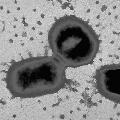



|
| This project is collaborated between The Forsyth Institute (TFI) and The Institute for Genomic Research (TIGR), and is funded by National Institute of Dental and Craniofacial Research (NIDCR) |
|
|
|||||||||||||||||||||||||
To the scientific communityBacterial genome projects have focused most heavily on two of at least ten major phyla of bacteria: the Proteobacteria, including Eschericheria coli, Vibrio cholerae, Haemophilus influenzae, Pseudomonas aeruginosa, Neisseria gonorroeae, and Helicobacter pylori; and the Gram-positive bacteria, including Mycoplasma genitalium, Bacillus subtilis, Streptococcus pneumoniae, and Mycobacterium tuberculosis. The Porphyromonas gingivalis genome project will produce information on an organism representing the major group of Gram-negative anaerobes: the Cytophaga\Flavobacter\Bacteroides (CFB) phylum. The CFB phylum is more distant from the Proteobacteria than are the Gram-positives (Woese, 1987). Therefore, the Porphyromonas gingivalis sequence will be extremely valuable for comparative genomics and furthering our understanding of bacterial diversity. The genome sequence will significantly enhance our understanding of the metabolism of Gram-negative anaerobes. The CFB organisms are naturally resistant to aminoglycoside and quinolone antibiotics used to treat Gram-negative aerobic bacterial infections (Rasmussen et. al., 1993). As resistance to tetracyclines and beta-lactam antibiotics spread in the CFB group, new and specific antibiotics are needed. Metronidazole, clindamycin, and chloramphenicol are currently the most effective antibiotics against CFB infections, but resistance to each of these antibiotics has appeared (Rasmussen et. al., 1993). The Porphyromonas gingivalis genome project will substantially enhance our ability to find new gene targets for antibiotics against Gram-negative anaerobes. There is evidence that genetic exchange can occur between resident microbiota and mammalian host cells (Salyers 1996). Among the bacteria likely to participate in this type of gene exchange are obligate anaerobes such as Porphyromonas or Bacteroides which are present in high numbers in the body throughout life and live in close association with human cells. Examination of the Porphyromonas gingivalis genome may contain some "footprints" of such transfer events in the form of genes significantly more closely related to human genes than to bacterial homologs. |
||||
|
This page is created and maintained by Drs. Margaret Duncan, Floyd Dewhirst, and Tsute Chen, Department of Molecular Genetics, The Forsyth Institute . Last modified on 02/20/2002 Copyright 2000, 2001, 2002 by The Forsyth Institute |